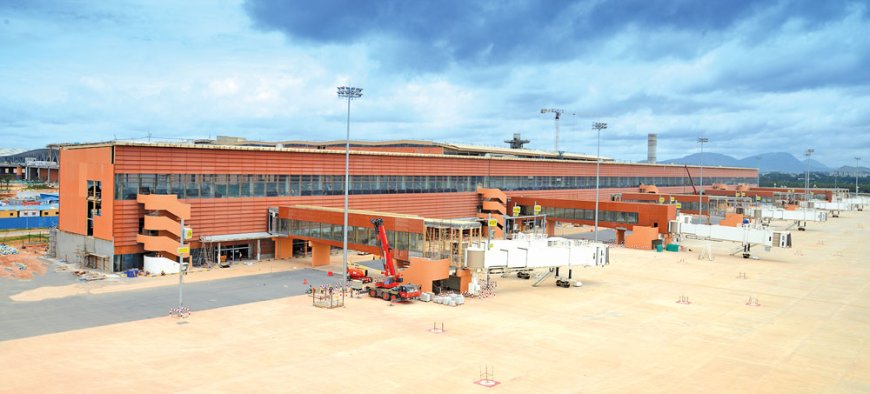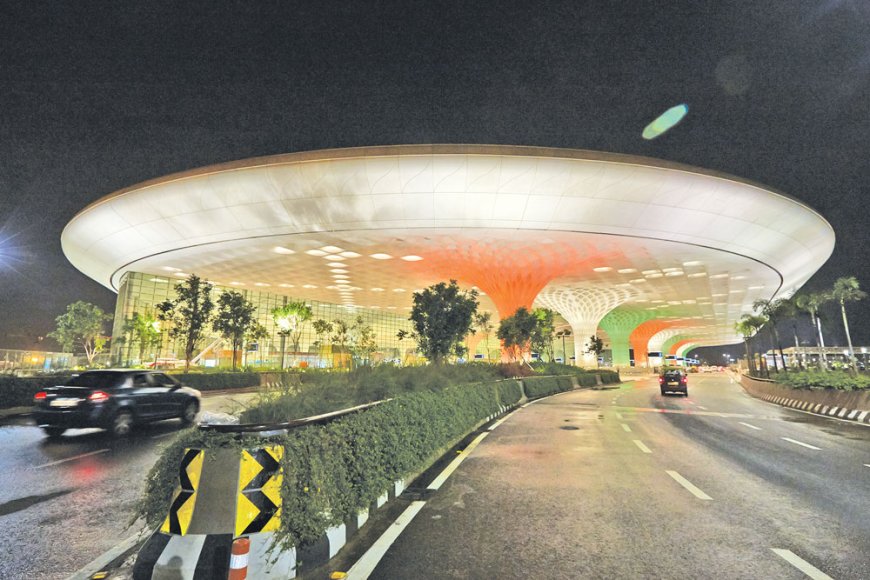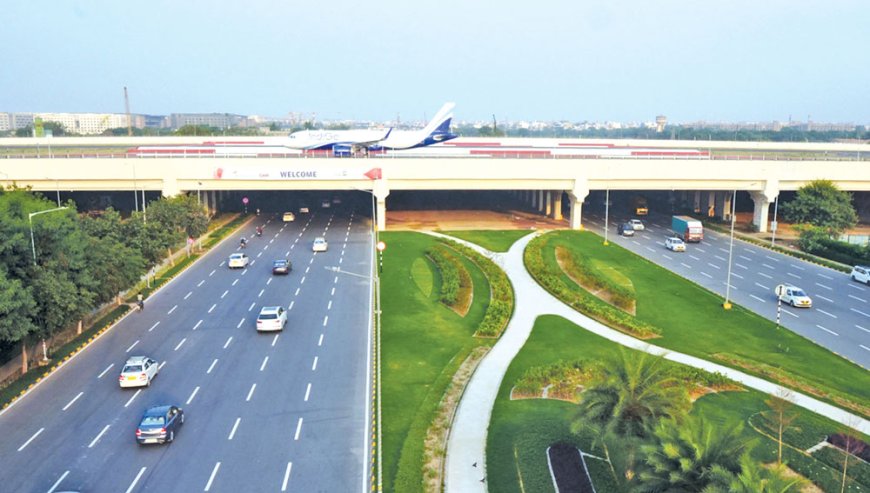India’s airports and aviation sector is on a path of transformation.

Sthaladipti Saha
How do you look at the current scenario in the Indian airports and aviation sector?
India’s airports & aviation sector is currently growing rapidly, backed by significant investments and numerous opportunities despite facing some challenges. Passenger traffic is soaring due to a rising middle class, affordable air travel, and increased domestic tourism. New airports are being developed, and existing ones expanded, to handle the increased traffic. Significant projects include the Navi Mumbai Airport, Jewar Airport near Delhi and developments in Bagdogra, Varanasi, Hyderabad, Chennai, and Bengaluru. Initiatives like the UDAN scheme are enhancing regional connectivity, making air travel more accessible to smaller towns and cities.
The Public-Private Partnership (PPP) model is attracting private investment, leading to the modernization of airport infrastructure. Indian airports are adopting advanced technologies such as biometric-based boarding, AI for operational efficiency, enhanced security measures, high-tech baggage handling systems, and digital boarding passes.
However, the sector faces challenges such as capacity constraints which are being systemically addressed, especially in major airports like Delhi and Mumbai, environmental concerns, and operational challenges to maintain high service standards and security.
Looking forward, the government has set ambitious targets to further increase the number of air travellers, and the fast-growing economy is boosting both aviation traffic and cargo, with a stronger focus on regional connectivity and sustainability. As a result, we will see more Tier 2 and Tier 3 cities getting connected to major metros and more green airports and eco-friendly practices being adopted. I am confident that the airports and aviation sector is on a path of transformation, balancing growth with the need to address capacity, despite various challenges.

How is the airport infrastructure development picking up in the country?
Airport infrastructure development in India is picking up significant momentum, thanks to a mix of government initiatives and substantial investments which is driving growth and modernization. A robust growth trajectory is driven by projections from the International Air Transport Association (IATA) and industry experts who foresee a compound annual growth rate (CAGR) of 6-8% over the next decade. By 2037, the Indian government expects the number of air travellers to reach around 520 million, positioning India as one of the fastest-growing aviation markets globally.
The cornerstone of this growth is the government’s policies and programs. The UDAN (Ude Desh ka Aam Naagrik) scheme, for instance, that aims to enhance regional connectivity by making air travel more affordable has already operationalized numerous regional airports. Additionally, the National Civil Aviation Policy (NCAP) provides a comprehensive framework for the aviation sector to take off on the back of infrastructure development and greater private participation. Public-Private Partnerships (PPP) have also contributed with the expansion of major airports in Delhi, Mumbai, Bengaluru, and Hyderabad, and creation of a new one in Mopa (Goa), PPP attracts private investment and expertise, leading to efficient and modern airport infrastructure.
Other airports, such as those in Lucknow and Ahmedabad, are also following this model. Along with government thrust, investment and funding play crucial roles as well. The Airports Authority of India (AAI) has planned significant capital expenditure for modernizing existing airports and constructing new ones in cities like Varanasi, Bagdogra, Pune, Tiruchirappalli, Kochi, Gorakhpur, Guwahati, Patna, and Jaipur. Additionally, the government is encouraging foreign direct investment (FDI) in airport infrastructure, bringing in more capital and technological knowledge.
Technological advancements are a key focus, with airports adopting cutting-edge technologies to enhance passenger experience and operational efficiency like biometric-based boarding, automated check-in and baggage handling systems, and AI-driven traffic management systems. Major projects and developments are underway, with several new greenfield airports either under construction or in the planning stage like the Navi Mumbai International Airport, Jewar Airport (Noida International Airport) near Delhi, and Vizag. Designed to handle large passenger volumes, these airports will feature state-of-the-art facilities. Further, secondary airports in metro cities and airports in Tier 2 and Tier 3 cities are being expanded and upgraded.

How do you look at the new airport facilities contributing to India’s economic development?
The development of new airports and expansion of facilities in India is significantly bolstering the country's economic development. Apart from creating opportunities for the citizens, it creates jobs through the entire life cycle of construction, operations, maintenance, and management. Indirect jobs also emerge in sectors such as hospitality, retail, and transportation. Additionally, modern and efficient airport facilities attract both domestic and foreign investments by enhancing connectivity and infrastructure, that are crucial for businesses.
Connectivity: The UDAN scheme has been pivotal in improving regional connectivity with new airports linking smaller towns and cities to major urban centers, to facilitate regional economic growth. It has improved connectivity, given a boost to tourism with better access to both popular and emerging tourist destinations that in turn lead to higher revenue for local businesses, including hotels, restaurants, and tour operators.
Trade and commerce: New and upgraded airports with modern cargo handling facilities support the growth of air freight, crucial especially for sectors like pharmaceuticals, electronics, and perishables. Efficient cargo operations reduce transportation time and costs, enhancing the competitiveness of Indian goods in global markets. Improved airport facilities also cater to the needs of business travellers, encouraging business expansions, partnerships, and investments.
Regional and national economic impact: Airports often function as catalysts for developing economic clusters or zones, attracting various industries and leading to the development of surrounding areas that can result in new business districts, technology parks, and industrial hubs. The growth of the aviation sector, supported by new airport facilities, significantly boosts the national GDP. Enhanced air connectivity fosters trade, tourism, and investment, collectively driving overall economic growth.
New airport developments in India and their likely impact:
- Navi Mumbai International Airport - aims to decongest Mumbai's existing airport and support the city’s growth as a major financial and commercial hub.
- Mopa Airport in Goa: Designed to cater to increasing tourist traffic, it will enhance the state’s tourism infrastructure and economic development.
- Jewar Airport (Noida International Airport) - set to become one of India’s largest airports. It will enhance connectivity in the National Capital Region (NCR) and stimulate economic activities in the area.
All these developments will be a catalyst to driving broader economic growth across the country.
Which are your major airport projects currently under execution?
We have recently completed the Bengaluru International Airport Expansion, Hyderabad International Airport Expansion and Delhi International Airport Expansion.
We are currently executing Navi Mumbai International Airport Phase 1, Vishakhapatnam International Airport Phase 1, and Chennai International Airport Expansion.
What are the technologies and methods used for faster and efficient execution of your airport projects?
When it comes to executing airport projects efficiently in India, we're leveraging cutting-edge technologies and innovative methods. Here's how we're making it happen:
Advanced construction technologies: We extensively use Building Information Modelling (BIM) to create detailed 3D models of airport structures that not only enhances design accuracy but also improves planning and allows us to manage construction processes more efficiently. BIM helps to visualize the entire project lifecycle, manage risks proactively, and optimize resources.
Modular construction is another game-changer that involves assembling building sections off-site and then bringing them to the construction site for installation. This method speeds up the process significantly, especially for critical core and cell works.
Digital and smart technologies incorporating Internet of Things (IoT) devices and sensors have revolutionized how we monitor construction activities, equipment, and environmental conditions in real time that enhances safety, improves resource management, and ensures that projects stay on schedule. IoT also enables predictive maintenance of construction equipment, reducing downtime and increasing efficiency.
Artificial Intelligence (AI) and Machine Learning (ML) play a crucial role to optimize construction schedules and managing risks effectively. By analyzing large datasets, these technologies help us make informed decisions, predict potential delays, and suggest strategies to keep our projects running smoothly.
Efficient Project Management practices: We’ve embraced Agile Project Management methodologies to enhance flexibility and responsiveness and to adapt quickly to changing project requirements through iterative planning and continuous feedback. This approach ensures better coordination among our teams and speeds up issue resolution.
Lean Construction principles are integral to our approach too. By minimizing waste, optimizing workflows, and continuously improving our processes, we're able to streamline our operations, reduce costs, shorten timelines, and deliver higher quality outcomes.
Sustainable and green technologies: Sustainability is a key focus for us. We integrate green building practices into our projects, using eco-friendly materials and energy-efficient systems. Pursuing certifications like LEED ensures that our construction practices are environmentally responsible. Additionally, we incorporate renewable energy sources such as solar panels to power our airport facilities, reducing carbon footprint and promoting long-term sustainability.
Collaborative and integrated platforms: Comprehensive project management software, like Primavera, plays a key role to effectively manage timelines, resources, budgets, and communication. These platforms provide real-time updates, enhance collaboration among our stakeholders, and ensure seamless coordination throughout the project lifecycle.
Integrated communication systems further facilitate smooth communication and decision-making among our project teams, contractors, and stakeholders. By keeping everyone informed and aligned, these systems help us address challenges quickly and ensure that our projects stay on track.
With the use of advanced construction technologies, digital innovations, efficient project management practices, sustainable approaches, and collaborative platforms, we’re driving faster and more efficient execution of airport projects across India. These innovations not only meet the growing demand for modern airport infrastructure, but also set new standards for excellence in construction and project management.

What opportunities do you look forward for your business in the current scenario?
In the current landscape, there are exciting opportunities for business growth.
Expanding and modernizing airports: There’s a big opportunity in upgrading existing airports—improving terminals, runways, and support systems—to handle the increasing flow of passengers and cargo effectively.
New airport projects: Large airport projects that are currently underway including the Navi Mumbai International Airport are prime examples of large-scale opportunities for businesses to get involved in significant infrastructure developments.
Sustainability and Green Tech: With sustainability in the spotlight, there’s a rising demand for eco-friendly materials, energy-efficient systems, and renewable energy solutions in airport construction.







